Health Promotion and Illness Prevention Program: Diabetes Report
VerifiedAdded on 2021/04/22
|12
|2856
|74
Report
AI Summary
This report delves into the critical aspects of health promotion and illness prevention, specifically targeting diabetes type 2, a significant health concern in Australia, particularly among Aboriginal and Torres Strait Islander communities. The report outlines a comprehensive health promotion program, detailing its stages: assessment, analysis, planning, implementation, and evaluation. The assessment phase highlights the economic and health impacts of diabetes, including complications like blindness and amputations, emphasizing the need for intervention. The analysis stage examines health data, revealing the prevalence of diabetes and associated complications, necessitating community awareness and intervention strategies. The planning phase involves staff training, resource gathering, and coordination with local authorities. Implementation focuses on community training, health awareness campaigns, and community involvement. Finally, the evaluation stage includes measuring program variables, evaluating staff performance, and gathering participant feedback. The report also acknowledges potential challenges like cultural diversity, communication barriers, and political hurdles, offering insights into effective program execution. Ultimately, the report underscores the importance of health promotion in mitigating the impact of diabetes and promoting healthier lifestyles.
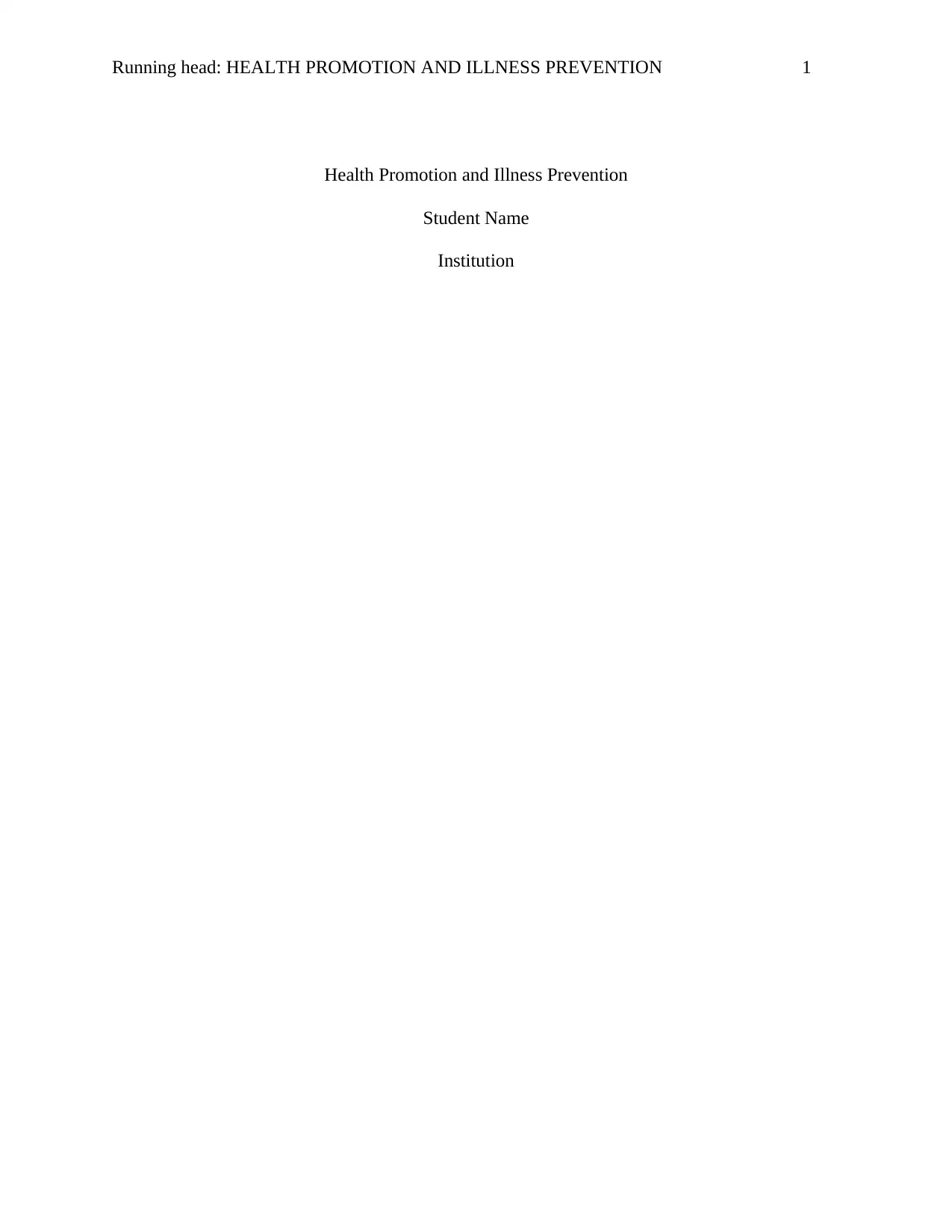
Running head: HEALTH PROMOTION AND ILLNESS PREVENTION 1
Health Promotion and Illness Prevention
Student Name
Institution
Health Promotion and Illness Prevention
Student Name
Institution
Paraphrase This Document
Need a fresh take? Get an instant paraphrase of this document with our AI Paraphraser
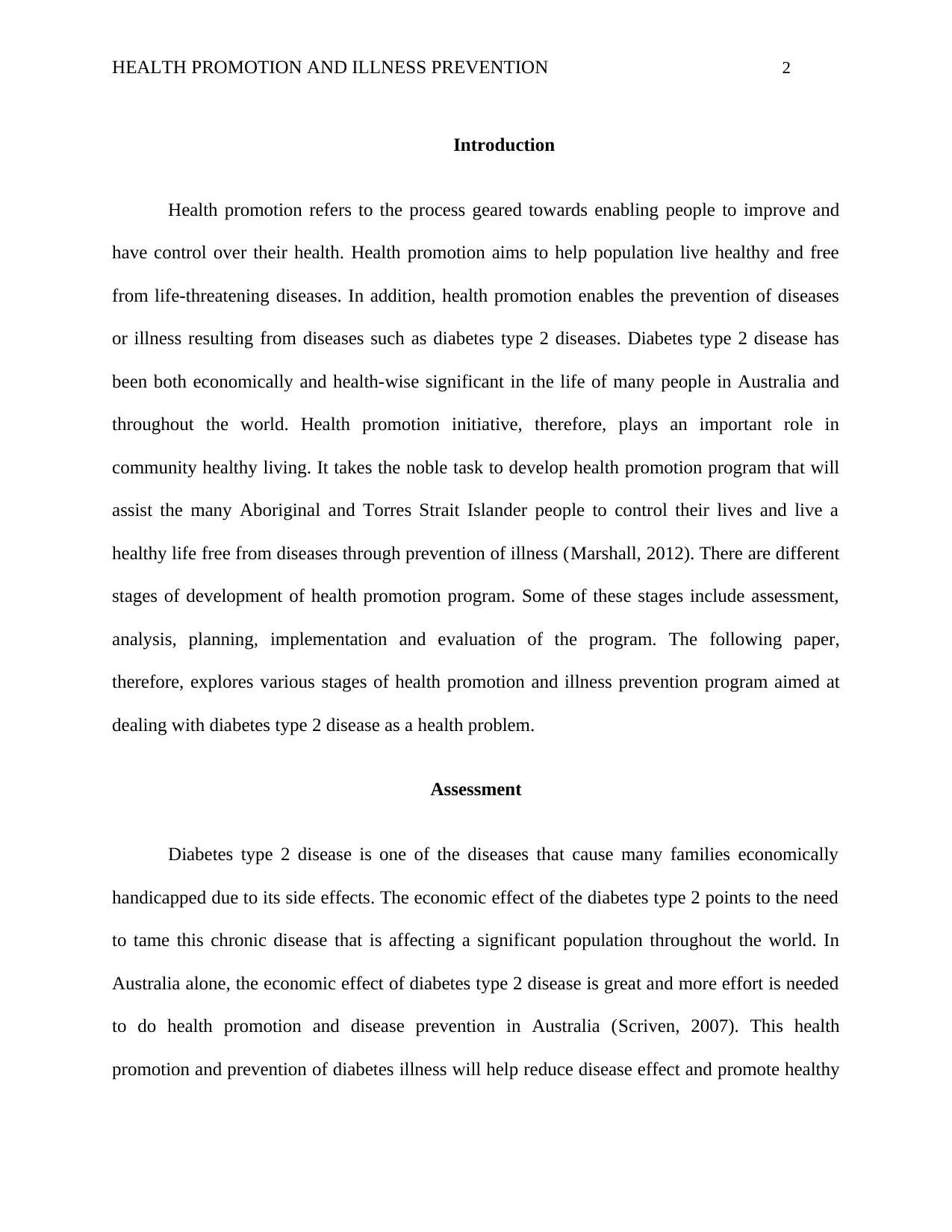
HEALTH PROMOTION AND ILLNESS PREVENTION 2
Introduction
Health promotion refers to the process geared towards enabling people to improve and
have control over their health. Health promotion aims to help population live healthy and free
from life-threatening diseases. In addition, health promotion enables the prevention of diseases
or illness resulting from diseases such as diabetes type 2 diseases. Diabetes type 2 disease has
been both economically and health-wise significant in the life of many people in Australia and
throughout the world. Health promotion initiative, therefore, plays an important role in
community healthy living. It takes the noble task to develop health promotion program that will
assist the many Aboriginal and Torres Strait Islander people to control their lives and live a
healthy life free from diseases through prevention of illness (Marshall, 2012). There are different
stages of development of health promotion program. Some of these stages include assessment,
analysis, planning, implementation and evaluation of the program. The following paper,
therefore, explores various stages of health promotion and illness prevention program aimed at
dealing with diabetes type 2 disease as a health problem.
Assessment
Diabetes type 2 disease is one of the diseases that cause many families economically
handicapped due to its side effects. The economic effect of the diabetes type 2 points to the need
to tame this chronic disease that is affecting a significant population throughout the world. In
Australia alone, the economic effect of diabetes type 2 disease is great and more effort is needed
to do health promotion and disease prevention in Australia (Scriven, 2007). This health
promotion and prevention of diabetes illness will help reduce disease effect and promote healthy
Introduction
Health promotion refers to the process geared towards enabling people to improve and
have control over their health. Health promotion aims to help population live healthy and free
from life-threatening diseases. In addition, health promotion enables the prevention of diseases
or illness resulting from diseases such as diabetes type 2 diseases. Diabetes type 2 disease has
been both economically and health-wise significant in the life of many people in Australia and
throughout the world. Health promotion initiative, therefore, plays an important role in
community healthy living. It takes the noble task to develop health promotion program that will
assist the many Aboriginal and Torres Strait Islander people to control their lives and live a
healthy life free from diseases through prevention of illness (Marshall, 2012). There are different
stages of development of health promotion program. Some of these stages include assessment,
analysis, planning, implementation and evaluation of the program. The following paper,
therefore, explores various stages of health promotion and illness prevention program aimed at
dealing with diabetes type 2 disease as a health problem.
Assessment
Diabetes type 2 disease is one of the diseases that cause many families economically
handicapped due to its side effects. The economic effect of the diabetes type 2 points to the need
to tame this chronic disease that is affecting a significant population throughout the world. In
Australia alone, the economic effect of diabetes type 2 disease is great and more effort is needed
to do health promotion and disease prevention in Australia (Scriven, 2007). This health
promotion and prevention of diabetes illness will help reduce disease effect and promote healthy
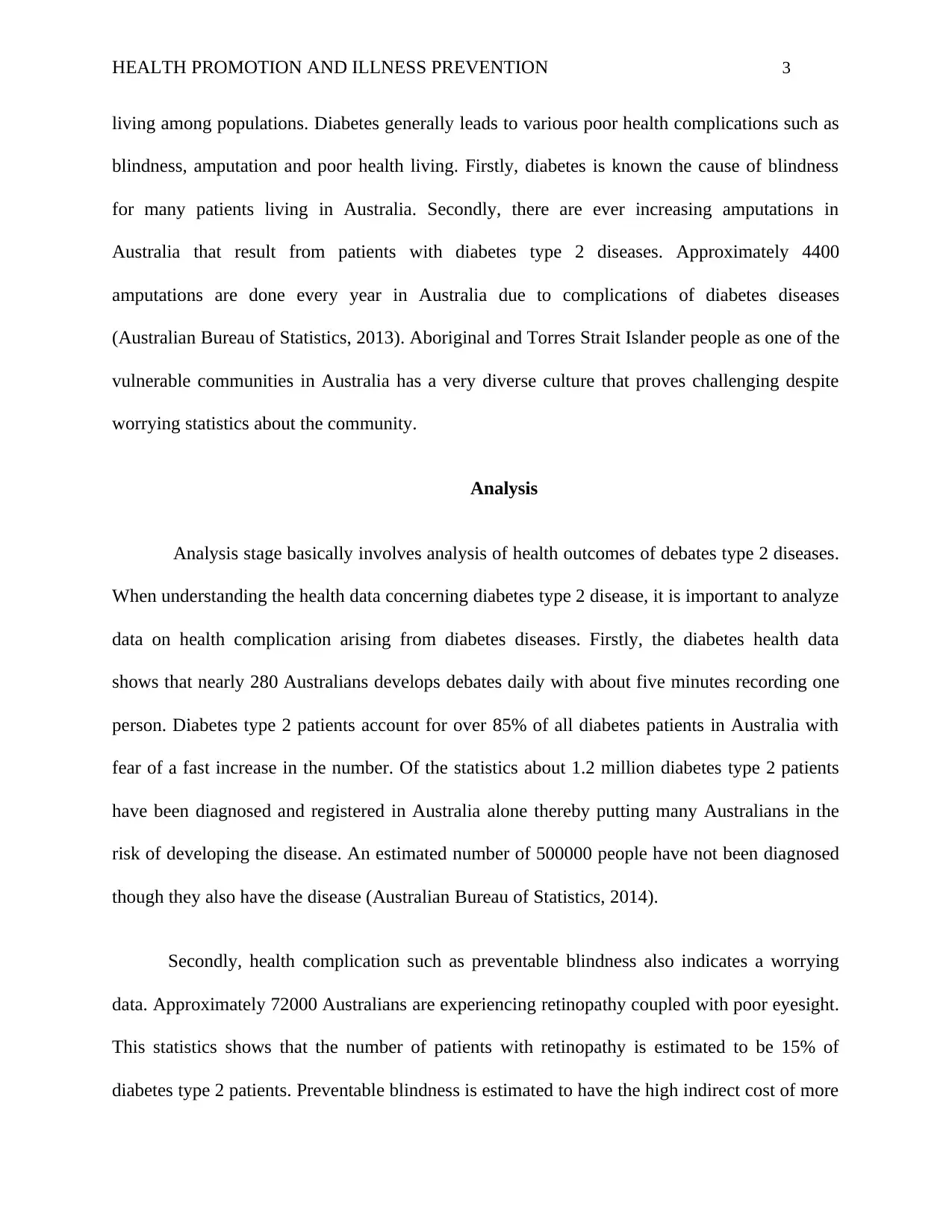
HEALTH PROMOTION AND ILLNESS PREVENTION 3
living among populations. Diabetes generally leads to various poor health complications such as
blindness, amputation and poor health living. Firstly, diabetes is known the cause of blindness
for many patients living in Australia. Secondly, there are ever increasing amputations in
Australia that result from patients with diabetes type 2 diseases. Approximately 4400
amputations are done every year in Australia due to complications of diabetes diseases
(Australian Bureau of Statistics, 2013). Aboriginal and Torres Strait Islander people as one of the
vulnerable communities in Australia has a very diverse culture that proves challenging despite
worrying statistics about the community.
Analysis
Analysis stage basically involves analysis of health outcomes of debates type 2 diseases.
When understanding the health data concerning diabetes type 2 disease, it is important to analyze
data on health complication arising from diabetes diseases. Firstly, the diabetes health data
shows that nearly 280 Australians develops debates daily with about five minutes recording one
person. Diabetes type 2 patients account for over 85% of all diabetes patients in Australia with
fear of a fast increase in the number. Of the statistics about 1.2 million diabetes type 2 patients
have been diagnosed and registered in Australia alone thereby putting many Australians in the
risk of developing the disease. An estimated number of 500000 people have not been diagnosed
though they also have the disease (Australian Bureau of Statistics, 2014).
Secondly, health complication such as preventable blindness also indicates a worrying
data. Approximately 72000 Australians are experiencing retinopathy coupled with poor eyesight.
This statistics shows that the number of patients with retinopathy is estimated to be 15% of
diabetes type 2 patients. Preventable blindness is estimated to have the high indirect cost of more
living among populations. Diabetes generally leads to various poor health complications such as
blindness, amputation and poor health living. Firstly, diabetes is known the cause of blindness
for many patients living in Australia. Secondly, there are ever increasing amputations in
Australia that result from patients with diabetes type 2 diseases. Approximately 4400
amputations are done every year in Australia due to complications of diabetes diseases
(Australian Bureau of Statistics, 2013). Aboriginal and Torres Strait Islander people as one of the
vulnerable communities in Australia has a very diverse culture that proves challenging despite
worrying statistics about the community.
Analysis
Analysis stage basically involves analysis of health outcomes of debates type 2 diseases.
When understanding the health data concerning diabetes type 2 disease, it is important to analyze
data on health complication arising from diabetes diseases. Firstly, the diabetes health data
shows that nearly 280 Australians develops debates daily with about five minutes recording one
person. Diabetes type 2 patients account for over 85% of all diabetes patients in Australia with
fear of a fast increase in the number. Of the statistics about 1.2 million diabetes type 2 patients
have been diagnosed and registered in Australia alone thereby putting many Australians in the
risk of developing the disease. An estimated number of 500000 people have not been diagnosed
though they also have the disease (Australian Bureau of Statistics, 2014).
Secondly, health complication such as preventable blindness also indicates a worrying
data. Approximately 72000 Australians are experiencing retinopathy coupled with poor eyesight.
This statistics shows that the number of patients with retinopathy is estimated to be 15% of
diabetes type 2 patients. Preventable blindness is estimated to have the high indirect cost of more
⊘ This is a preview!⊘
Do you want full access?
Subscribe today to unlock all pages.

Trusted by 1+ million students worldwide
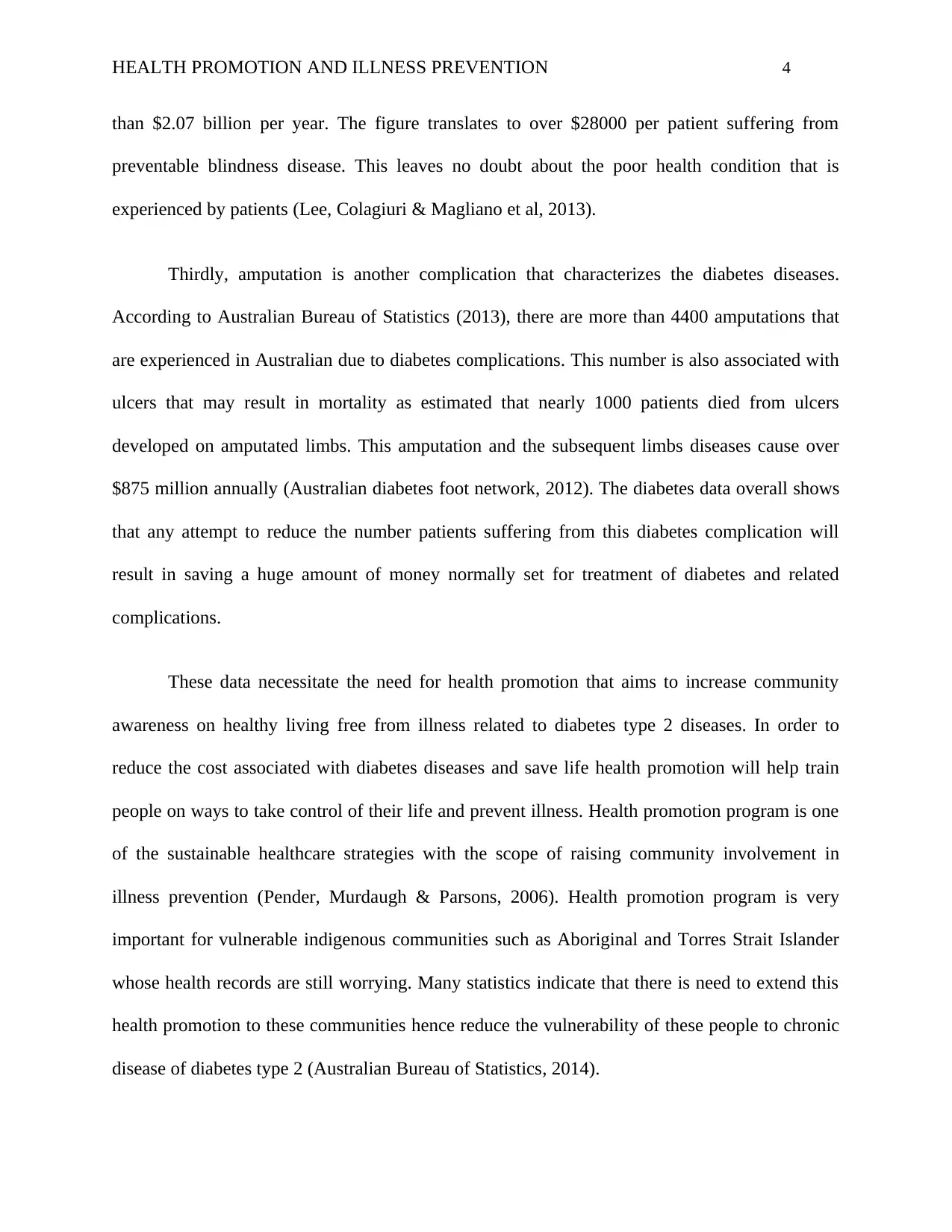
HEALTH PROMOTION AND ILLNESS PREVENTION 4
than $2.07 billion per year. The figure translates to over $28000 per patient suffering from
preventable blindness disease. This leaves no doubt about the poor health condition that is
experienced by patients (Lee, Colagiuri & Magliano et al, 2013).
Thirdly, amputation is another complication that characterizes the diabetes diseases.
According to Australian Bureau of Statistics (2013), there are more than 4400 amputations that
are experienced in Australian due to diabetes complications. This number is also associated with
ulcers that may result in mortality as estimated that nearly 1000 patients died from ulcers
developed on amputated limbs. This amputation and the subsequent limbs diseases cause over
$875 million annually (Australian diabetes foot network, 2012). The diabetes data overall shows
that any attempt to reduce the number patients suffering from this diabetes complication will
result in saving a huge amount of money normally set for treatment of diabetes and related
complications.
These data necessitate the need for health promotion that aims to increase community
awareness on healthy living free from illness related to diabetes type 2 diseases. In order to
reduce the cost associated with diabetes diseases and save life health promotion will help train
people on ways to take control of their life and prevent illness. Health promotion program is one
of the sustainable healthcare strategies with the scope of raising community involvement in
illness prevention (Pender, Murdaugh & Parsons, 2006). Health promotion program is very
important for vulnerable indigenous communities such as Aboriginal and Torres Strait Islander
whose health records are still worrying. Many statistics indicate that there is need to extend this
health promotion to these communities hence reduce the vulnerability of these people to chronic
disease of diabetes type 2 (Australian Bureau of Statistics, 2014).
than $2.07 billion per year. The figure translates to over $28000 per patient suffering from
preventable blindness disease. This leaves no doubt about the poor health condition that is
experienced by patients (Lee, Colagiuri & Magliano et al, 2013).
Thirdly, amputation is another complication that characterizes the diabetes diseases.
According to Australian Bureau of Statistics (2013), there are more than 4400 amputations that
are experienced in Australian due to diabetes complications. This number is also associated with
ulcers that may result in mortality as estimated that nearly 1000 patients died from ulcers
developed on amputated limbs. This amputation and the subsequent limbs diseases cause over
$875 million annually (Australian diabetes foot network, 2012). The diabetes data overall shows
that any attempt to reduce the number patients suffering from this diabetes complication will
result in saving a huge amount of money normally set for treatment of diabetes and related
complications.
These data necessitate the need for health promotion that aims to increase community
awareness on healthy living free from illness related to diabetes type 2 diseases. In order to
reduce the cost associated with diabetes diseases and save life health promotion will help train
people on ways to take control of their life and prevent illness. Health promotion program is one
of the sustainable healthcare strategies with the scope of raising community involvement in
illness prevention (Pender, Murdaugh & Parsons, 2006). Health promotion program is very
important for vulnerable indigenous communities such as Aboriginal and Torres Strait Islander
whose health records are still worrying. Many statistics indicate that there is need to extend this
health promotion to these communities hence reduce the vulnerability of these people to chronic
disease of diabetes type 2 (Australian Bureau of Statistics, 2014).
Paraphrase This Document
Need a fresh take? Get an instant paraphrase of this document with our AI Paraphraser
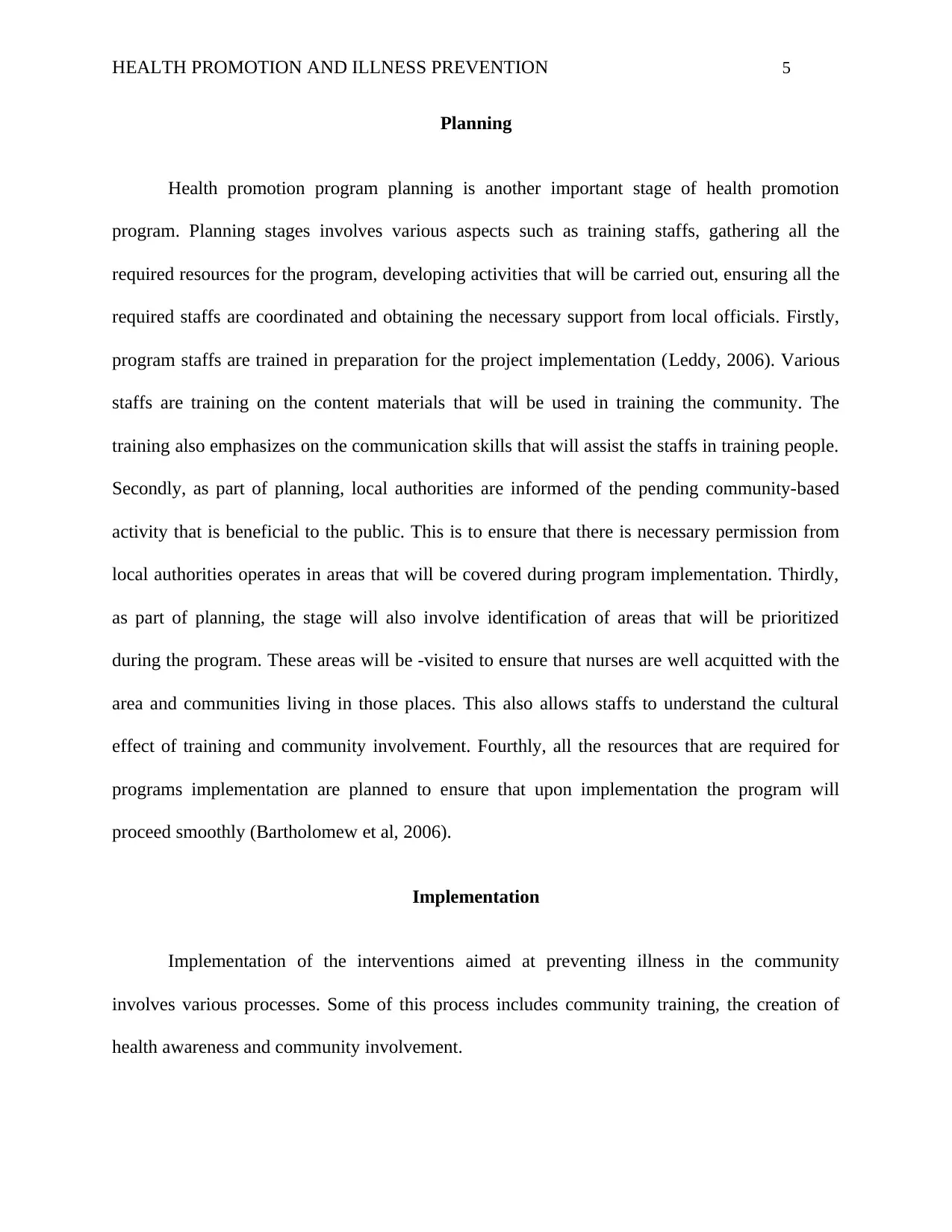
HEALTH PROMOTION AND ILLNESS PREVENTION 5
Planning
Health promotion program planning is another important stage of health promotion
program. Planning stages involves various aspects such as training staffs, gathering all the
required resources for the program, developing activities that will be carried out, ensuring all the
required staffs are coordinated and obtaining the necessary support from local officials. Firstly,
program staffs are trained in preparation for the project implementation (Leddy, 2006). Various
staffs are training on the content materials that will be used in training the community. The
training also emphasizes on the communication skills that will assist the staffs in training people.
Secondly, as part of planning, local authorities are informed of the pending community-based
activity that is beneficial to the public. This is to ensure that there is necessary permission from
local authorities operates in areas that will be covered during program implementation. Thirdly,
as part of planning, the stage will also involve identification of areas that will be prioritized
during the program. These areas will be -visited to ensure that nurses are well acquitted with the
area and communities living in those places. This also allows staffs to understand the cultural
effect of training and community involvement. Fourthly, all the resources that are required for
programs implementation are planned to ensure that upon implementation the program will
proceed smoothly (Bartholomew et al, 2006).
Implementation
Implementation of the interventions aimed at preventing illness in the community
involves various processes. Some of this process includes community training, the creation of
health awareness and community involvement.
Planning
Health promotion program planning is another important stage of health promotion
program. Planning stages involves various aspects such as training staffs, gathering all the
required resources for the program, developing activities that will be carried out, ensuring all the
required staffs are coordinated and obtaining the necessary support from local officials. Firstly,
program staffs are trained in preparation for the project implementation (Leddy, 2006). Various
staffs are training on the content materials that will be used in training the community. The
training also emphasizes on the communication skills that will assist the staffs in training people.
Secondly, as part of planning, local authorities are informed of the pending community-based
activity that is beneficial to the public. This is to ensure that there is necessary permission from
local authorities operates in areas that will be covered during program implementation. Thirdly,
as part of planning, the stage will also involve identification of areas that will be prioritized
during the program. These areas will be -visited to ensure that nurses are well acquitted with the
area and communities living in those places. This also allows staffs to understand the cultural
effect of training and community involvement. Fourthly, all the resources that are required for
programs implementation are planned to ensure that upon implementation the program will
proceed smoothly (Bartholomew et al, 2006).
Implementation
Implementation of the interventions aimed at preventing illness in the community
involves various processes. Some of this process includes community training, the creation of
health awareness and community involvement.
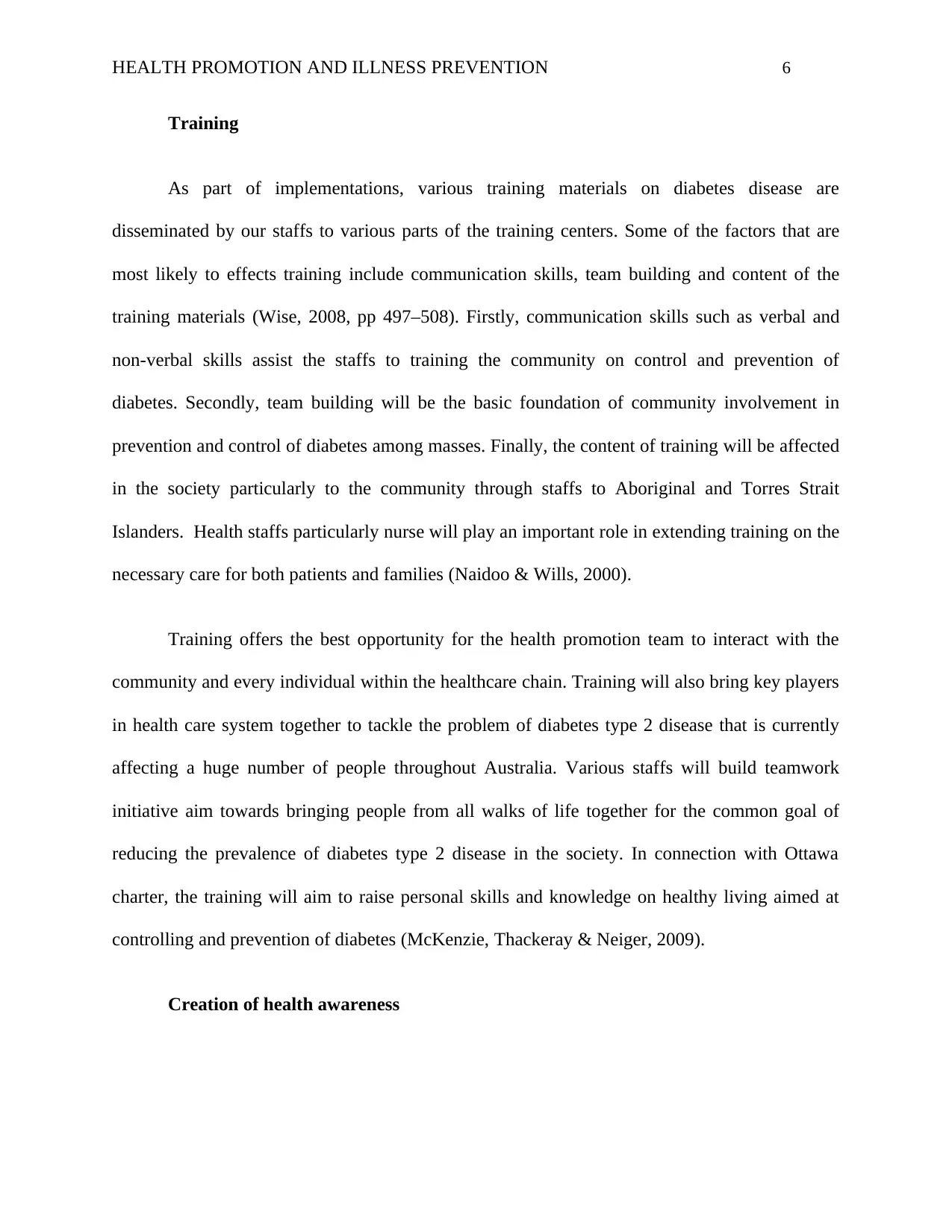
HEALTH PROMOTION AND ILLNESS PREVENTION 6
Training
As part of implementations, various training materials on diabetes disease are
disseminated by our staffs to various parts of the training centers. Some of the factors that are
most likely to effects training include communication skills, team building and content of the
training materials (Wise, 2008, pp 497–508). Firstly, communication skills such as verbal and
non-verbal skills assist the staffs to training the community on control and prevention of
diabetes. Secondly, team building will be the basic foundation of community involvement in
prevention and control of diabetes among masses. Finally, the content of training will be affected
in the society particularly to the community through staffs to Aboriginal and Torres Strait
Islanders. Health staffs particularly nurse will play an important role in extending training on the
necessary care for both patients and families (Naidoo & Wills, 2000).
Training offers the best opportunity for the health promotion team to interact with the
community and every individual within the healthcare chain. Training will also bring key players
in health care system together to tackle the problem of diabetes type 2 disease that is currently
affecting a huge number of people throughout Australia. Various staffs will build teamwork
initiative aim towards bringing people from all walks of life together for the common goal of
reducing the prevalence of diabetes type 2 disease in the society. In connection with Ottawa
charter, the training will aim to raise personal skills and knowledge on healthy living aimed at
controlling and prevention of diabetes (McKenzie, Thackeray & Neiger, 2009).
Creation of health awareness
Training
As part of implementations, various training materials on diabetes disease are
disseminated by our staffs to various parts of the training centers. Some of the factors that are
most likely to effects training include communication skills, team building and content of the
training materials (Wise, 2008, pp 497–508). Firstly, communication skills such as verbal and
non-verbal skills assist the staffs to training the community on control and prevention of
diabetes. Secondly, team building will be the basic foundation of community involvement in
prevention and control of diabetes among masses. Finally, the content of training will be affected
in the society particularly to the community through staffs to Aboriginal and Torres Strait
Islanders. Health staffs particularly nurse will play an important role in extending training on the
necessary care for both patients and families (Naidoo & Wills, 2000).
Training offers the best opportunity for the health promotion team to interact with the
community and every individual within the healthcare chain. Training will also bring key players
in health care system together to tackle the problem of diabetes type 2 disease that is currently
affecting a huge number of people throughout Australia. Various staffs will build teamwork
initiative aim towards bringing people from all walks of life together for the common goal of
reducing the prevalence of diabetes type 2 disease in the society. In connection with Ottawa
charter, the training will aim to raise personal skills and knowledge on healthy living aimed at
controlling and prevention of diabetes (McKenzie, Thackeray & Neiger, 2009).
Creation of health awareness
⊘ This is a preview!⊘
Do you want full access?
Subscribe today to unlock all pages.

Trusted by 1+ million students worldwide
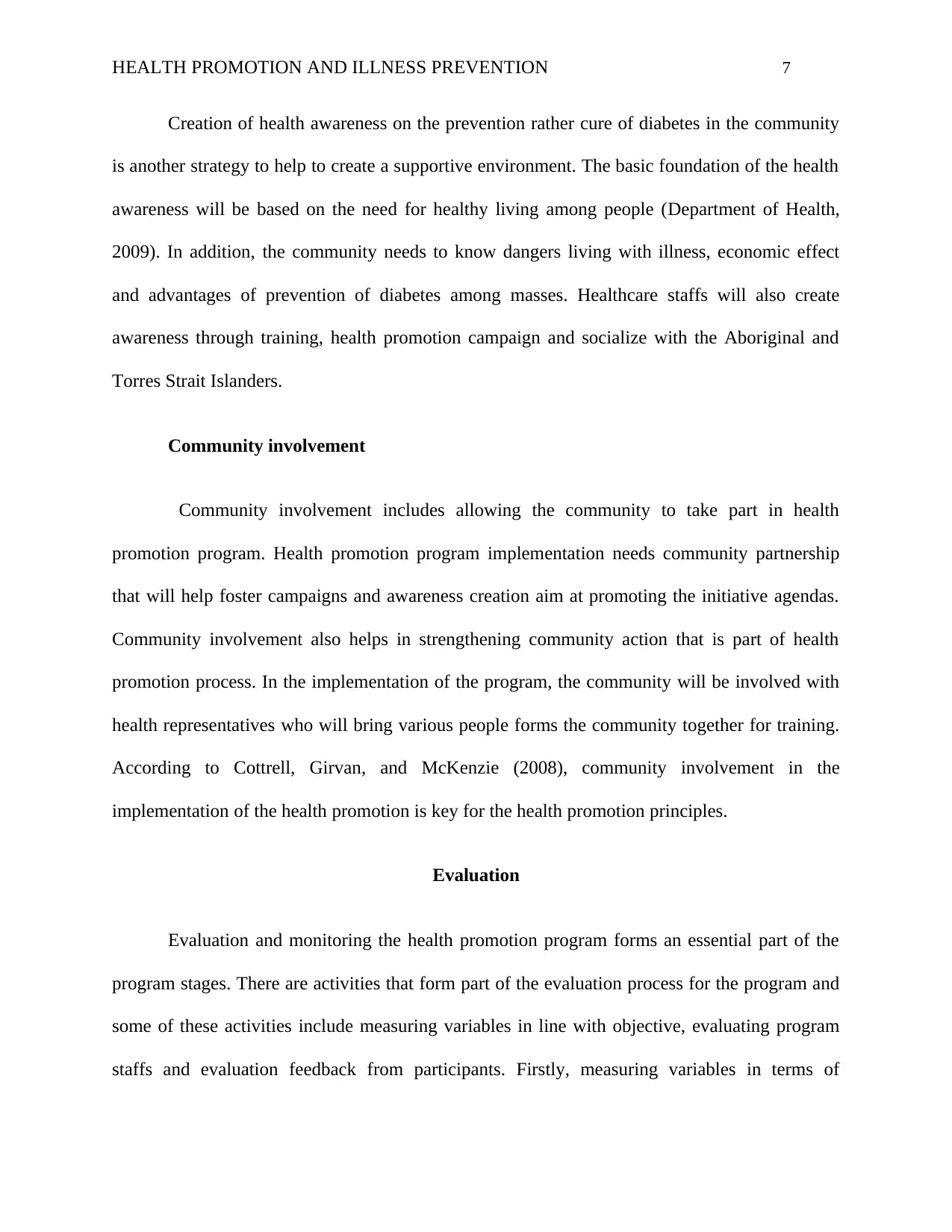
HEALTH PROMOTION AND ILLNESS PREVENTION 7
Creation of health awareness on the prevention rather cure of diabetes in the community
is another strategy to help to create a supportive environment. The basic foundation of the health
awareness will be based on the need for healthy living among people (Department of Health,
2009). In addition, the community needs to know dangers living with illness, economic effect
and advantages of prevention of diabetes among masses. Healthcare staffs will also create
awareness through training, health promotion campaign and socialize with the Aboriginal and
Torres Strait Islanders.
Community involvement
Community involvement includes allowing the community to take part in health
promotion program. Health promotion program implementation needs community partnership
that will help foster campaigns and awareness creation aim at promoting the initiative agendas.
Community involvement also helps in strengthening community action that is part of health
promotion process. In the implementation of the program, the community will be involved with
health representatives who will bring various people forms the community together for training.
According to Cottrell, Girvan, and McKenzie (2008), community involvement in the
implementation of the health promotion is key for the health promotion principles.
Evaluation
Evaluation and monitoring the health promotion program forms an essential part of the
program stages. There are activities that form part of the evaluation process for the program and
some of these activities include measuring variables in line with objective, evaluating program
staffs and evaluation feedback from participants. Firstly, measuring variables in terms of
Creation of health awareness on the prevention rather cure of diabetes in the community
is another strategy to help to create a supportive environment. The basic foundation of the health
awareness will be based on the need for healthy living among people (Department of Health,
2009). In addition, the community needs to know dangers living with illness, economic effect
and advantages of prevention of diabetes among masses. Healthcare staffs will also create
awareness through training, health promotion campaign and socialize with the Aboriginal and
Torres Strait Islanders.
Community involvement
Community involvement includes allowing the community to take part in health
promotion program. Health promotion program implementation needs community partnership
that will help foster campaigns and awareness creation aim at promoting the initiative agendas.
Community involvement also helps in strengthening community action that is part of health
promotion process. In the implementation of the program, the community will be involved with
health representatives who will bring various people forms the community together for training.
According to Cottrell, Girvan, and McKenzie (2008), community involvement in the
implementation of the health promotion is key for the health promotion principles.
Evaluation
Evaluation and monitoring the health promotion program forms an essential part of the
program stages. There are activities that form part of the evaluation process for the program and
some of these activities include measuring variables in line with objective, evaluating program
staffs and evaluation feedback from participants. Firstly, measuring variables in terms of
Paraphrase This Document
Need a fresh take? Get an instant paraphrase of this document with our AI Paraphraser
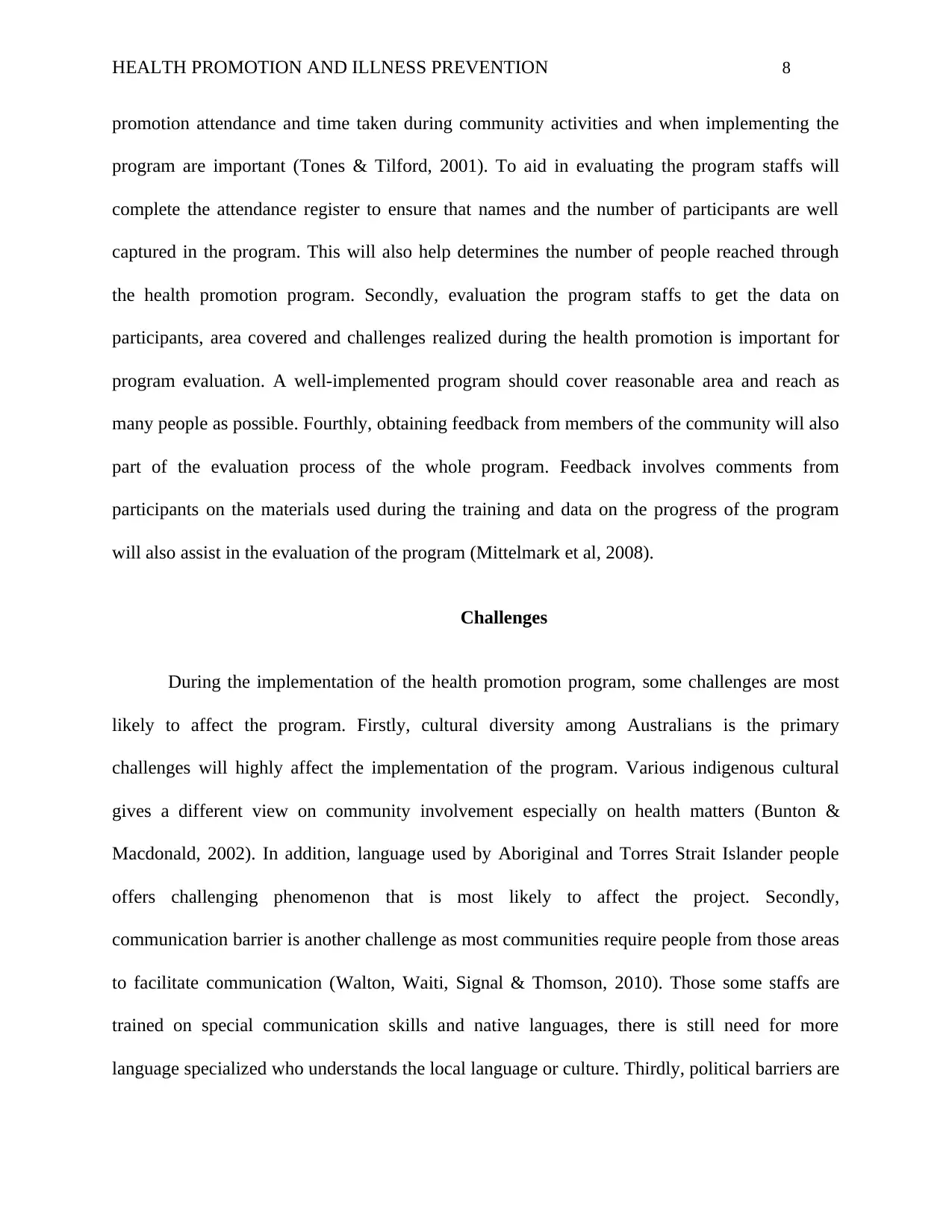
HEALTH PROMOTION AND ILLNESS PREVENTION 8
promotion attendance and time taken during community activities and when implementing the
program are important (Tones & Tilford, 2001). To aid in evaluating the program staffs will
complete the attendance register to ensure that names and the number of participants are well
captured in the program. This will also help determines the number of people reached through
the health promotion program. Secondly, evaluation the program staffs to get the data on
participants, area covered and challenges realized during the health promotion is important for
program evaluation. A well-implemented program should cover reasonable area and reach as
many people as possible. Fourthly, obtaining feedback from members of the community will also
part of the evaluation process of the whole program. Feedback involves comments from
participants on the materials used during the training and data on the progress of the program
will also assist in the evaluation of the program (Mittelmark et al, 2008).
Challenges
During the implementation of the health promotion program, some challenges are most
likely to affect the program. Firstly, cultural diversity among Australians is the primary
challenges will highly affect the implementation of the program. Various indigenous cultural
gives a different view on community involvement especially on health matters (Bunton &
Macdonald, 2002). In addition, language used by Aboriginal and Torres Strait Islander people
offers challenging phenomenon that is most likely to affect the project. Secondly,
communication barrier is another challenge as most communities require people from those areas
to facilitate communication (Walton, Waiti, Signal & Thomson, 2010). Those some staffs are
trained on special communication skills and native languages, there is still need for more
language specialized who understands the local language or culture. Thirdly, political barriers are
promotion attendance and time taken during community activities and when implementing the
program are important (Tones & Tilford, 2001). To aid in evaluating the program staffs will
complete the attendance register to ensure that names and the number of participants are well
captured in the program. This will also help determines the number of people reached through
the health promotion program. Secondly, evaluation the program staffs to get the data on
participants, area covered and challenges realized during the health promotion is important for
program evaluation. A well-implemented program should cover reasonable area and reach as
many people as possible. Fourthly, obtaining feedback from members of the community will also
part of the evaluation process of the whole program. Feedback involves comments from
participants on the materials used during the training and data on the progress of the program
will also assist in the evaluation of the program (Mittelmark et al, 2008).
Challenges
During the implementation of the health promotion program, some challenges are most
likely to affect the program. Firstly, cultural diversity among Australians is the primary
challenges will highly affect the implementation of the program. Various indigenous cultural
gives a different view on community involvement especially on health matters (Bunton &
Macdonald, 2002). In addition, language used by Aboriginal and Torres Strait Islander people
offers challenging phenomenon that is most likely to affect the project. Secondly,
communication barrier is another challenge as most communities require people from those areas
to facilitate communication (Walton, Waiti, Signal & Thomson, 2010). Those some staffs are
trained on special communication skills and native languages, there is still need for more
language specialized who understands the local language or culture. Thirdly, political barriers are
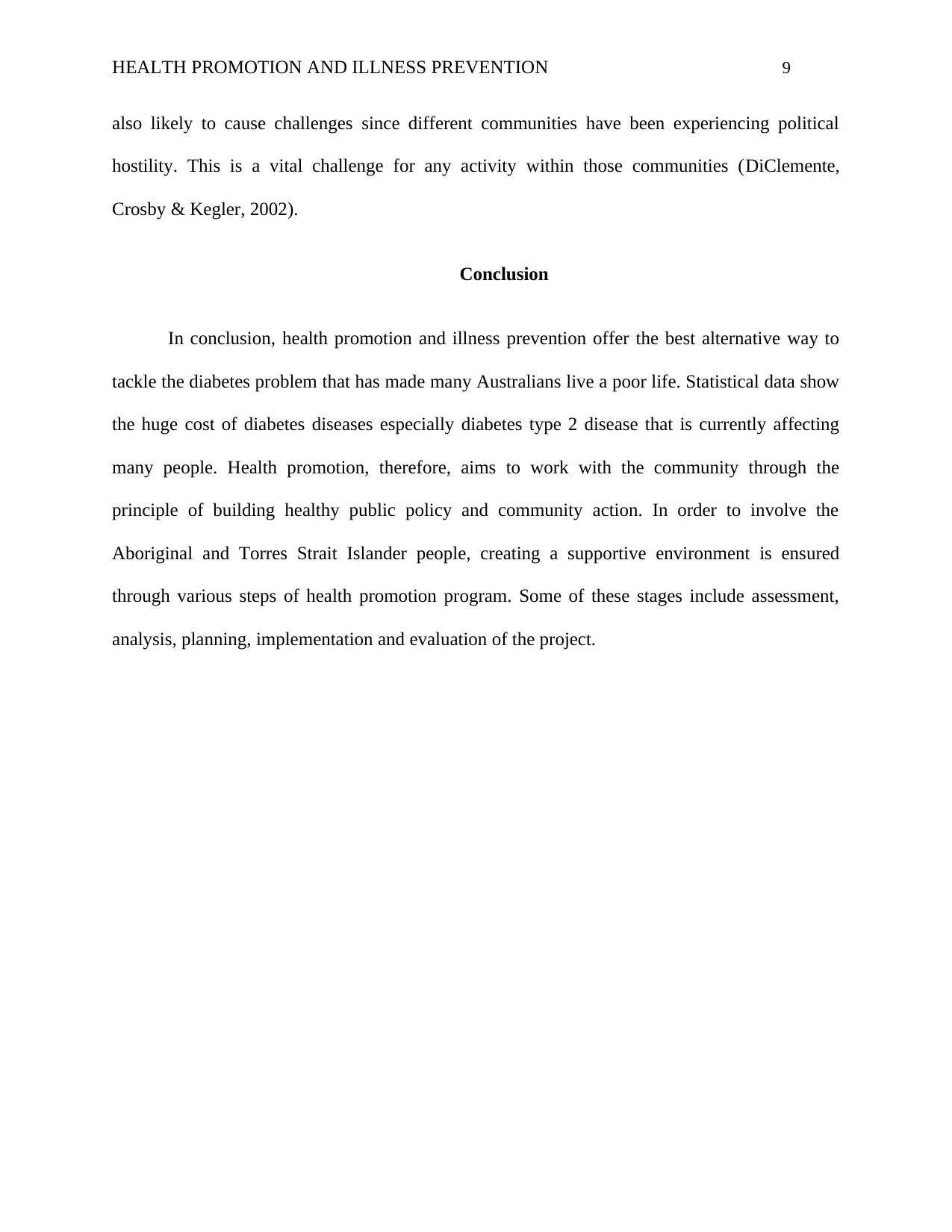
HEALTH PROMOTION AND ILLNESS PREVENTION 9
also likely to cause challenges since different communities have been experiencing political
hostility. This is a vital challenge for any activity within those communities (DiClemente,
Crosby & Kegler, 2002).
Conclusion
In conclusion, health promotion and illness prevention offer the best alternative way to
tackle the diabetes problem that has made many Australians live a poor life. Statistical data show
the huge cost of diabetes diseases especially diabetes type 2 disease that is currently affecting
many people. Health promotion, therefore, aims to work with the community through the
principle of building healthy public policy and community action. In order to involve the
Aboriginal and Torres Strait Islander people, creating a supportive environment is ensured
through various steps of health promotion program. Some of these stages include assessment,
analysis, planning, implementation and evaluation of the project.
also likely to cause challenges since different communities have been experiencing political
hostility. This is a vital challenge for any activity within those communities (DiClemente,
Crosby & Kegler, 2002).
Conclusion
In conclusion, health promotion and illness prevention offer the best alternative way to
tackle the diabetes problem that has made many Australians live a poor life. Statistical data show
the huge cost of diabetes diseases especially diabetes type 2 disease that is currently affecting
many people. Health promotion, therefore, aims to work with the community through the
principle of building healthy public policy and community action. In order to involve the
Aboriginal and Torres Strait Islander people, creating a supportive environment is ensured
through various steps of health promotion program. Some of these stages include assessment,
analysis, planning, implementation and evaluation of the project.
⊘ This is a preview!⊘
Do you want full access?
Subscribe today to unlock all pages.

Trusted by 1+ million students worldwide
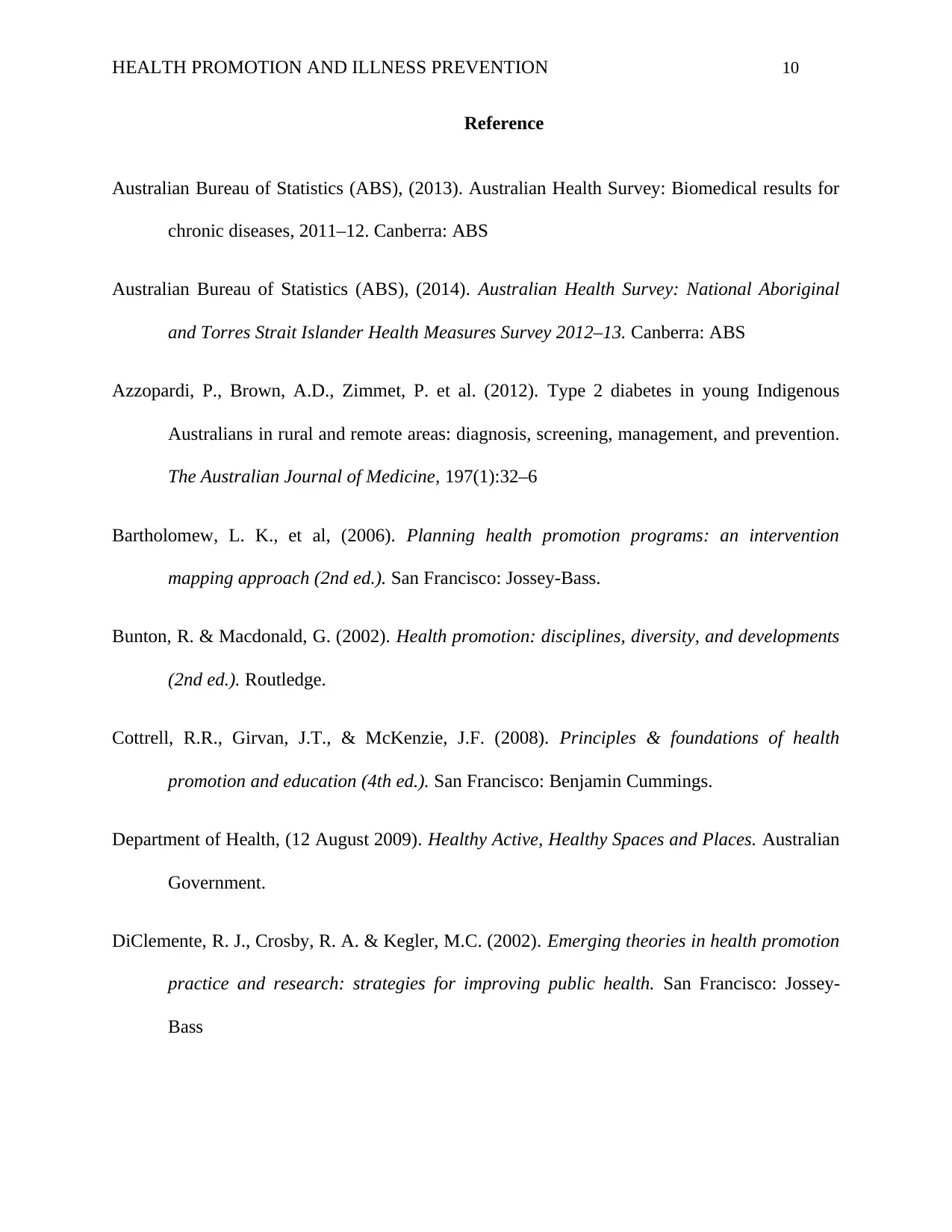
HEALTH PROMOTION AND ILLNESS PREVENTION 10
Reference
Australian Bureau of Statistics (ABS), (2013). Australian Health Survey: Biomedical results for
chronic diseases, 2011–12. Canberra: ABS
Australian Bureau of Statistics (ABS), (2014). Australian Health Survey: National Aboriginal
and Torres Strait Islander Health Measures Survey 2012–13. Canberra: ABS
Azzopardi, P., Brown, A.D., Zimmet, P. et al. (2012). Type 2 diabetes in young Indigenous
Australians in rural and remote areas: diagnosis, screening, management, and prevention.
The Australian Journal of Medicine, 197(1):32–6
Bartholomew, L. K., et al, (2006). Planning health promotion programs: an intervention
mapping approach (2nd ed.). San Francisco: Jossey-Bass.
Bunton, R. & Macdonald, G. (2002). Health promotion: disciplines, diversity, and developments
(2nd ed.). Routledge.
Cottrell, R.R., Girvan, J.T., & McKenzie, J.F. (2008). Principles & foundations of health
promotion and education (4th ed.). San Francisco: Benjamin Cummings.
Department of Health, (12 August 2009). Healthy Active, Healthy Spaces and Places. Australian
Government.
DiClemente, R. J., Crosby, R. A. & Kegler, M.C. (2002). Emerging theories in health promotion
practice and research: strategies for improving public health. San Francisco: Jossey-
Bass
Reference
Australian Bureau of Statistics (ABS), (2013). Australian Health Survey: Biomedical results for
chronic diseases, 2011–12. Canberra: ABS
Australian Bureau of Statistics (ABS), (2014). Australian Health Survey: National Aboriginal
and Torres Strait Islander Health Measures Survey 2012–13. Canberra: ABS
Azzopardi, P., Brown, A.D., Zimmet, P. et al. (2012). Type 2 diabetes in young Indigenous
Australians in rural and remote areas: diagnosis, screening, management, and prevention.
The Australian Journal of Medicine, 197(1):32–6
Bartholomew, L. K., et al, (2006). Planning health promotion programs: an intervention
mapping approach (2nd ed.). San Francisco: Jossey-Bass.
Bunton, R. & Macdonald, G. (2002). Health promotion: disciplines, diversity, and developments
(2nd ed.). Routledge.
Cottrell, R.R., Girvan, J.T., & McKenzie, J.F. (2008). Principles & foundations of health
promotion and education (4th ed.). San Francisco: Benjamin Cummings.
Department of Health, (12 August 2009). Healthy Active, Healthy Spaces and Places. Australian
Government.
DiClemente, R. J., Crosby, R. A. & Kegler, M.C. (2002). Emerging theories in health promotion
practice and research: strategies for improving public health. San Francisco: Jossey-
Bass
Paraphrase This Document
Need a fresh take? Get an instant paraphrase of this document with our AI Paraphraser
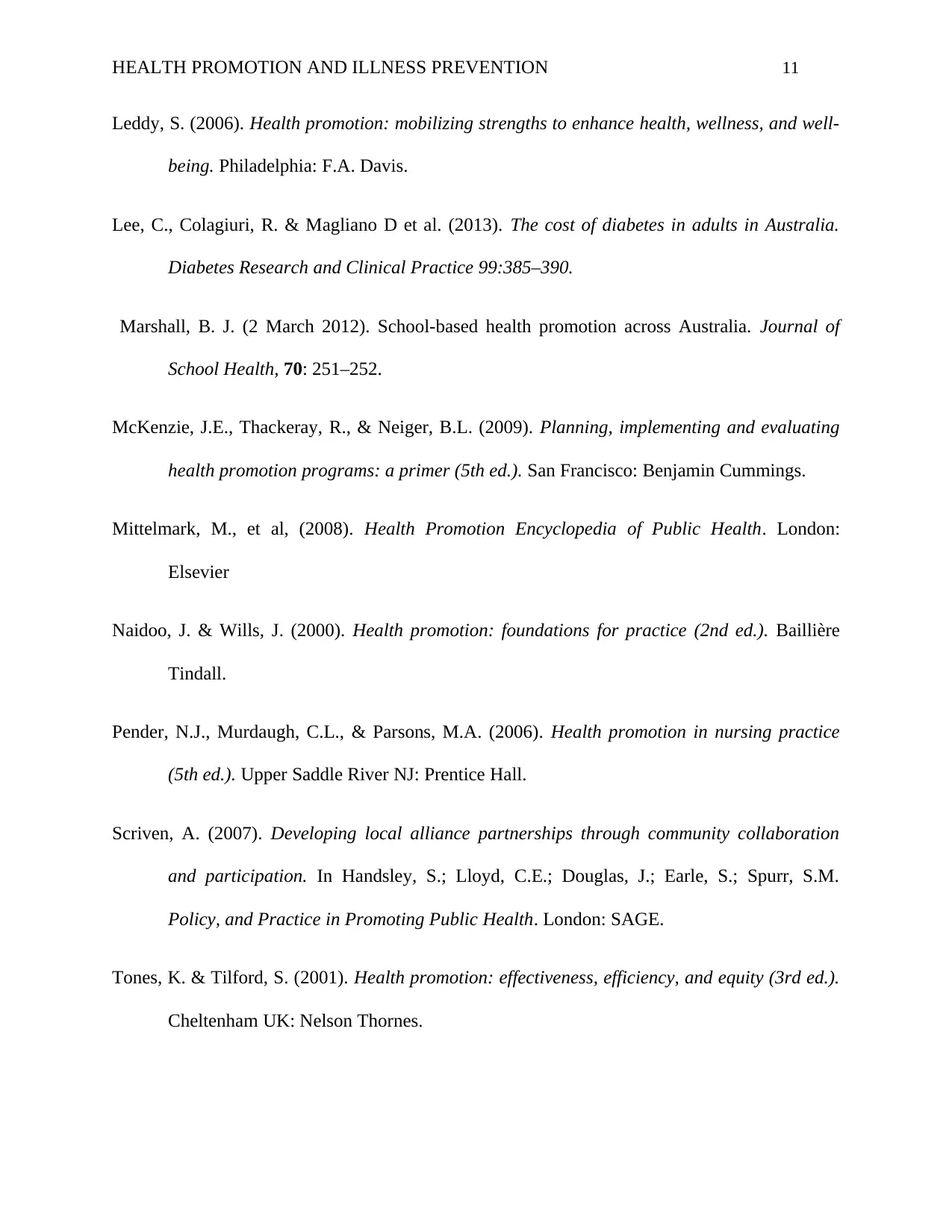
HEALTH PROMOTION AND ILLNESS PREVENTION 11
Leddy, S. (2006). Health promotion: mobilizing strengths to enhance health, wellness, and well-
being. Philadelphia: F.A. Davis.
Lee, C., Colagiuri, R. & Magliano D et al. (2013). The cost of diabetes in adults in Australia.
Diabetes Research and Clinical Practice 99:385–390.
Marshall, B. J. (2 March 2012). School-based health promotion across Australia. Journal of
School Health, 70: 251–252.
McKenzie, J.E., Thackeray, R., & Neiger, B.L. (2009). Planning, implementing and evaluating
health promotion programs: a primer (5th ed.). San Francisco: Benjamin Cummings.
Mittelmark, M., et al, (2008). Health Promotion Encyclopedia of Public Health. London:
Elsevier
Naidoo, J. & Wills, J. (2000). Health promotion: foundations for practice (2nd ed.). Baillière
Tindall.
Pender, N.J., Murdaugh, C.L., & Parsons, M.A. (2006). Health promotion in nursing practice
(5th ed.). Upper Saddle River NJ: Prentice Hall.
Scriven, A. (2007). Developing local alliance partnerships through community collaboration
and participation. In Handsley, S.; Lloyd, C.E.; Douglas, J.; Earle, S.; Spurr, S.M.
Policy, and Practice in Promoting Public Health. London: SAGE.
Tones, K. & Tilford, S. (2001). Health promotion: effectiveness, efficiency, and equity (3rd ed.).
Cheltenham UK: Nelson Thornes.
Leddy, S. (2006). Health promotion: mobilizing strengths to enhance health, wellness, and well-
being. Philadelphia: F.A. Davis.
Lee, C., Colagiuri, R. & Magliano D et al. (2013). The cost of diabetes in adults in Australia.
Diabetes Research and Clinical Practice 99:385–390.
Marshall, B. J. (2 March 2012). School-based health promotion across Australia. Journal of
School Health, 70: 251–252.
McKenzie, J.E., Thackeray, R., & Neiger, B.L. (2009). Planning, implementing and evaluating
health promotion programs: a primer (5th ed.). San Francisco: Benjamin Cummings.
Mittelmark, M., et al, (2008). Health Promotion Encyclopedia of Public Health. London:
Elsevier
Naidoo, J. & Wills, J. (2000). Health promotion: foundations for practice (2nd ed.). Baillière
Tindall.
Pender, N.J., Murdaugh, C.L., & Parsons, M.A. (2006). Health promotion in nursing practice
(5th ed.). Upper Saddle River NJ: Prentice Hall.
Scriven, A. (2007). Developing local alliance partnerships through community collaboration
and participation. In Handsley, S.; Lloyd, C.E.; Douglas, J.; Earle, S.; Spurr, S.M.
Policy, and Practice in Promoting Public Health. London: SAGE.
Tones, K. & Tilford, S. (2001). Health promotion: effectiveness, efficiency, and equity (3rd ed.).
Cheltenham UK: Nelson Thornes.
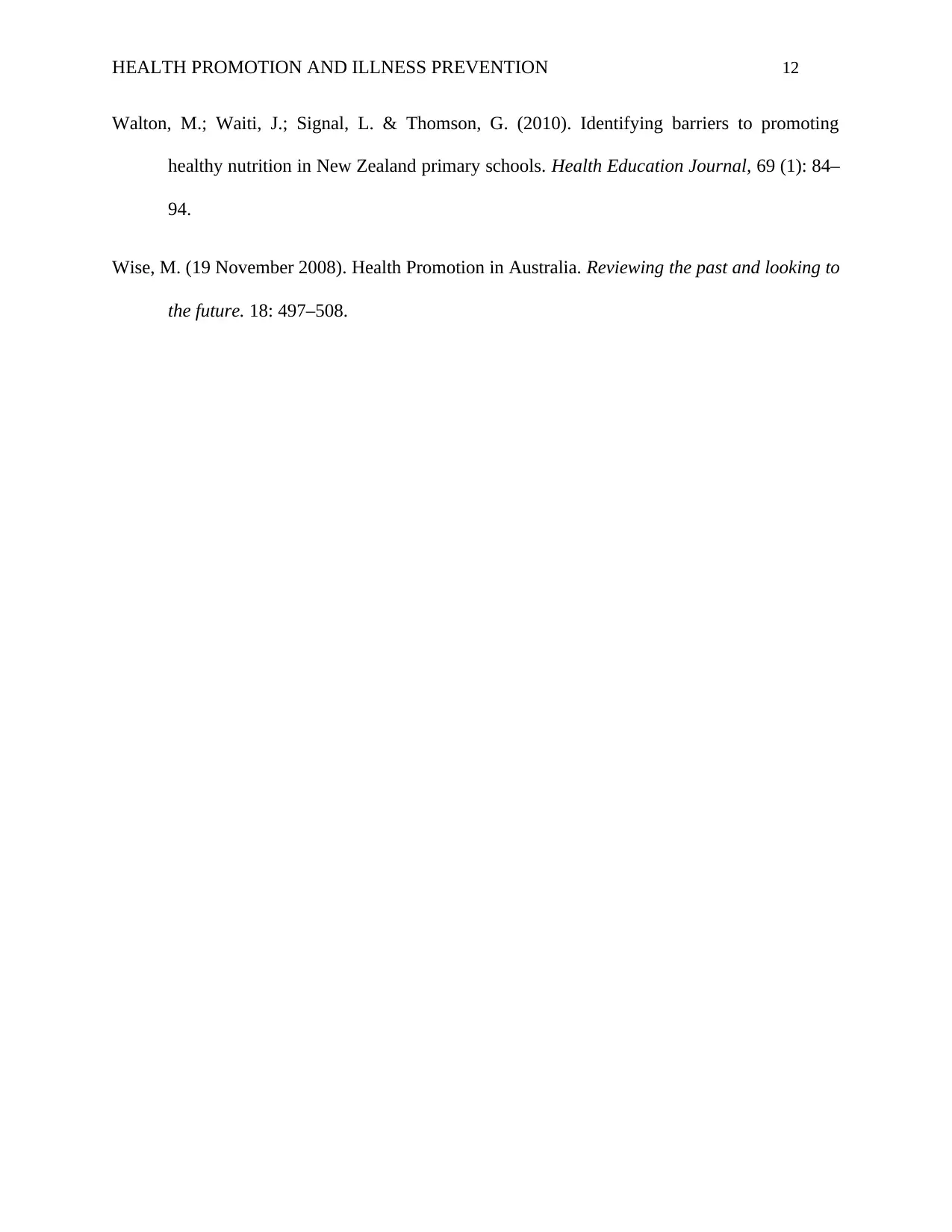
HEALTH PROMOTION AND ILLNESS PREVENTION 12
Walton, M.; Waiti, J.; Signal, L. & Thomson, G. (2010). Identifying barriers to promoting
healthy nutrition in New Zealand primary schools. Health Education Journal, 69 (1): 84–
94.
Wise, M. (19 November 2008). Health Promotion in Australia. Reviewing the past and looking to
the future. 18: 497–508.
Walton, M.; Waiti, J.; Signal, L. & Thomson, G. (2010). Identifying barriers to promoting
healthy nutrition in New Zealand primary schools. Health Education Journal, 69 (1): 84–
94.
Wise, M. (19 November 2008). Health Promotion in Australia. Reviewing the past and looking to
the future. 18: 497–508.
⊘ This is a preview!⊘
Do you want full access?
Subscribe today to unlock all pages.

Trusted by 1+ million students worldwide
1 out of 12
Related Documents
Your All-in-One AI-Powered Toolkit for Academic Success.
+13062052269
info@desklib.com
Available 24*7 on WhatsApp / Email
![[object Object]](/_next/static/media/star-bottom.7253800d.svg)
Unlock your academic potential
Copyright © 2020–2025 A2Z Services. All Rights Reserved. Developed and managed by ZUCOL.





